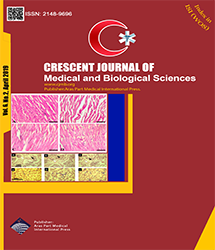
| Original Article | |
| Relationship of Epicardial and Subcutaneous Fatty Acids With Serum Lipids and Vascular Cramps in Patients Undergoing Coronary Artery Bypass Graft | |
| Hamideh Najjarpour-Jabbari1, Mohammad Nouri1, Masoud Pezeshkian1, Masoud Darabi1, Razieh Parizad1,2 | |
| 1Cardiovascular Research Center, Tabriz University, Medical Sciences, Tabriz, Iran 2Faculty of Nursing and Midwifery, Tabriz University of Medical Sciences, Tabriz, Iran |
|
|
CJMB 2019; 6: 201-208 Viewed : 5223 times Downloaded : 253 times. Keywords : Epicardial adipose tissue, Fatty acids, Cardiac artery bypass graft, Paraoxonase |
|
| | Related Articles | |
| Abstract | |
Objectives: Fatty acids may include saturated or unsaturated fat. It seems that the consumption of trans fatty acids (TFA) can raise the risk of coronary artery diseases (CADs). The composition of the fatty acids of epicardial and subcutaneous adipose tissues (SATs) is a proper biomarker for assessing the fat used in a long-term period; therefore, nutrition can affect this composition. In addition, the human serum paraoxonase enzyme is considered an estraz/lactonase whose activity decreases in coronary heart disease (CHD). The present study aimed to investigate the relationship between metabolic variables related to the fatty acid composition of epicardial and subcutaneous fatty tissues and the activity of the paraoxonase enzyme. Further, the current study sought to explore the regional differences between subcutaneous and epicardial fatty acids, and the relationship between these measurements, as well as metabolic variables and food. Materials and Methods: This descriptive cross-sectional study included 42 patients within the age range of 35-65 years who underwent coronary artery bypass graft. The fatty acid profile was measured by means of gas chromatography equipment, followed by estimating the lipid parameters of serum samples using commercial kits and enzymatic method in the autoanalyzer. Finally, paraoxonase enzyme activity was evaluated by Sigma chemical paraoxon substrate. Results: Based on the results, the amounts of saturated fatty acids (SFAs) such as meristic (14:0), palmitic (16:0), and stearic (18:0) acids of the epicardium were higher. However, the levels of unsaturated fatty acids including palmitoleic (16:1), oleic (18:1 n-9), linoleic (18:2 n-6), and linolenic acids of the epicardium were lower compared to the SAT. Further, hypertension had a positive relationship with 18:1 n-11 (r=0.349, P=0.024) while a negative relationship with 18:1 n-9 (r=0.319, P=0.041) and 18:2 n-6 (r=0.391, P=0.01) epicardial adipose tissues. Foods such as fruits and vegetables had a positive relationship with linolenic acid (18:3 n-9) and conjugated linolenic acid epicardium. Furthermore, paraoxonase enzyme activity reduced by increasing the number of vessel cramps. Moreover, body mass index was found to have a negative relationship with subcutaneous SFAs whereas a positive association with the subcutaneous palmitoleic acid (16:1 n-7). Conclusions: In general, the findings revealed that the amounts of subcutaneous and epicardial fatty acids vary in individuals with different CADs and that both types of fatty acids and serum lipid profile are correlated with each other. Additionally, there is a relationship between fatty acids of these two tissues and serum lipid profiles and food, as well as between paraoxonase enzyme and vascular cramps. |
Cite By, Google Scholar
Google Scholar
PubMed
Online Submission System
 CJMB ENDNOTE ® Style
CJMB ENDNOTE ® Style
 Tutorials
Tutorials
 Publication Charge
Medical and Biological Research Center
About Journal
Publication Charge
Medical and Biological Research Center
About Journal
Aras Part Medical International Press Editor-in-Chief
Arash Khaki
Deputy Editor
Zafer Akan


















